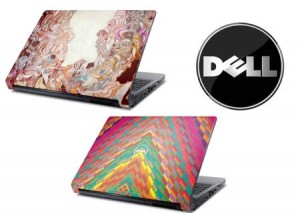i’m a vivienne tam
I’m fascinated by the recent flurry of activity of designer PCs. Having worked at Sony during the early years of VAIO (perhaps the first fashionable PC line, launched with its distinctive violet color and sleek features and all), it’s pretty amazing to me to see how the category has developed.
Both HP and Dell have introduced lines of designer PCs in the last couple of years.  HP’s launch of the Vivienne Tam Mini in early 2008 was the product of the PC maker’s partnership with the popular clothing designer and its success spawned a series of other limited editions.
HP’s launch of the Vivienne Tam Mini in early 2008 was the product of the PC maker’s partnership with the popular clothing designer and its success spawned a series of other limited editions.  In December of last year Dell launched Design Studio, a customization program in which customers pick from custom colors and pieces of artwork from artists.
In December of last year Dell launched Design Studio, a customization program in which customers pick from custom colors and pieces of artwork from artists.
A study of the two companies’ entries makes for some interesting comparisons.
Different Starting Points
HP’s efforts are rooted in its desire to attract more female customers. They reached out to Ms. Tam and eventually gave her complete control over the design of the Mini netbook. Satjiv Chahil, SVP-global marketing at HP, is quoted in a recent Ad Age write-up saying, “No tech company has ever addressed this market with great authenticity…Other efforts have been about making products pink. … This is a total fashion design...”
Dell was inspired by its history of made-to-order PCs when it decided to launch its Design Studio. In a Brandweek article, Dell’s VP of consumer experience design, Ed Boyd, is quoted as explaining the rationale behind the effort as: “You can have it Steve Jobs’ way or you can have it your way.” Their motivation is to deliver “the most personalized products in the world” – including the design.
Different Positionings
HP started off with a single Vivienne Tam product and has expanded the program slowly and selectively. The line now includes another Tam Mini along with a couple of other designers’ products and my sense is they will continue to emphasize the exclusivity of the designs. This is designer PC with the emphasis on design.
Dell launched with 100 choices of artwork and now there are more than 350 images available. Artwork comes from artists as well as “branding partners” such as Major League Baseball, (RED), and OPI nail polish. They change their offerings every quarter. As such, Dell has positioned the program squarely on the benefits of personalization.
Different Channels
In their own ways, both brands have eschewed traditional PC channels like Best Buy. In keeping with the fashion strategy, HP sells its designer PCs at fashion retailers such as Macy’s and Neiman Marcus. And Dell’s customized products are naturally only available through Dell.com.
Different Objectives
Although the Vivienne Tam Mini’s sales were so high that HP abandoned its original plan to make it a limited edition, it’s clear the line will never be a sales leader at the company. It is, however, believed to play a critical role in improving brand perceptions. “It raises the tide for all HP boats. It’s very specific and unique activity that’s lifted the entire company. The halo effect has been great,” Mr. Chahil said in Ad Age. As such, development costs for the line aren’t booked as an R&D expense but rather as a marketing one. “These are not products with a marketing program, these are in fact marketing tools,” said David Roman, VP-marketing communications, HP.
Dell has more grandiose plans for its designer PCs. The Brandweek piece reports the company hopes to see this kind of customization grow across much of its portfolio. The program is currently available in most of the Americas, but Boyd said Dell will be able to expand it worldwide by next summer. “What you’re seeing now is just the tip of the iceberg,” he declares.
Same Smarts
Both of these efforts are customer-centric developments in a category which is growing. Both represent exciting innovations at a time when many categories and companies are struggling with dry new product pipelines.
And although both approaches provide ways for customers to express themselves through their PC designs, each company is doing it in a way that makes sense for their brand. HP needed to boost its cool credentials and so launching an exclusive, high-fashion design line provides an appropriate brand perception boost. Dell, on the other hand, needed to reinvigorate their existing brand equity in customization – adding design into the mix opens a new avenue to do so.
Perhaps most significant of all is that, while the last few years has seen Apple waging war with its Mac vs. PC ads and Microsoft trying to fight back with its “I’m a PC” campaign, Dell and HP have taken the high road and actually developed products that take the self-expressive power of PCs to a new level.
related posts: